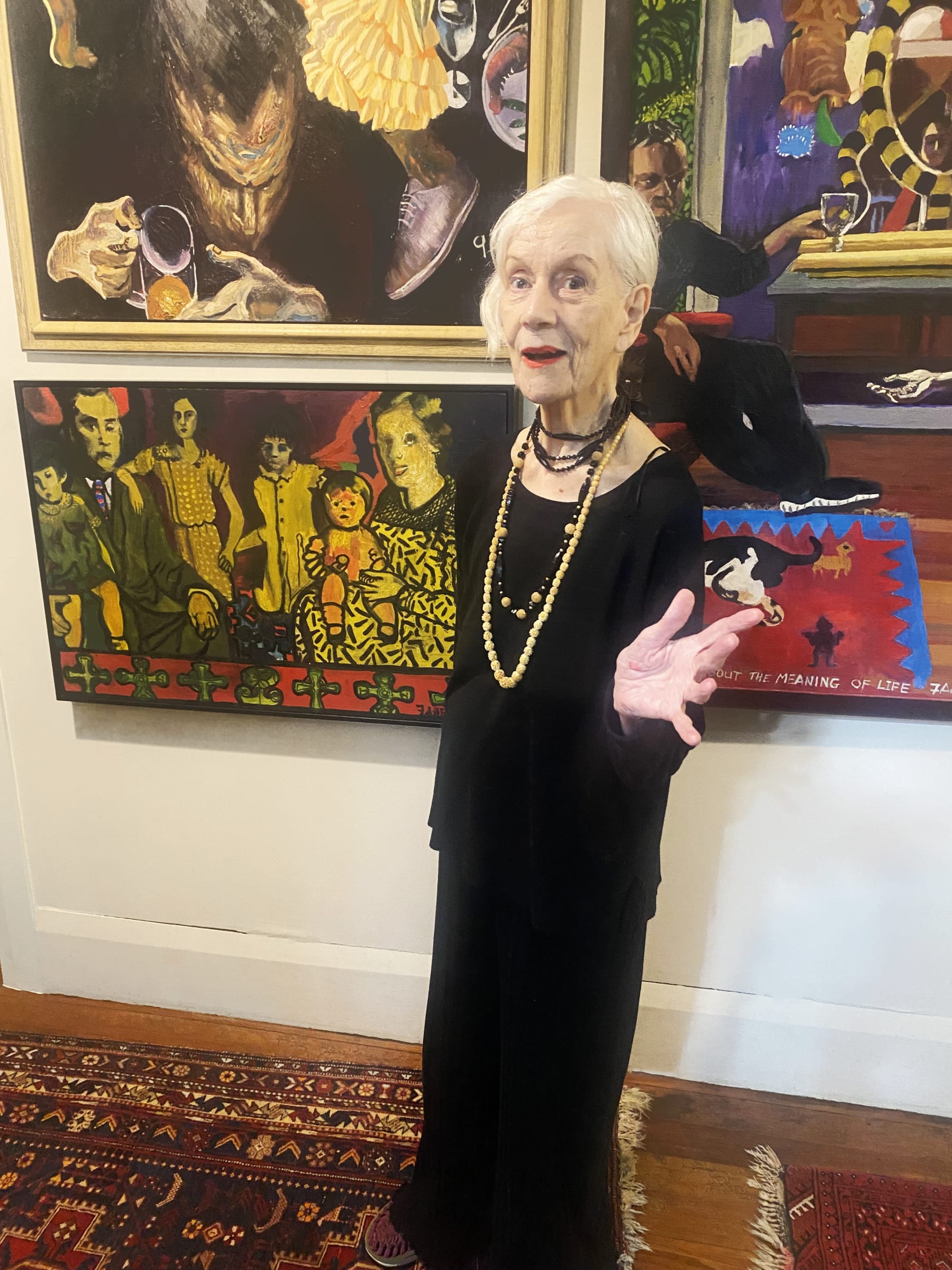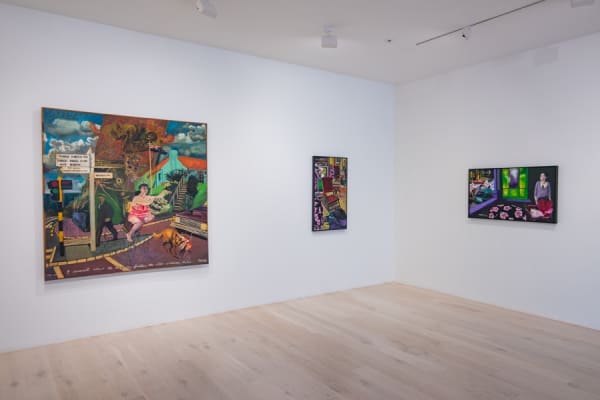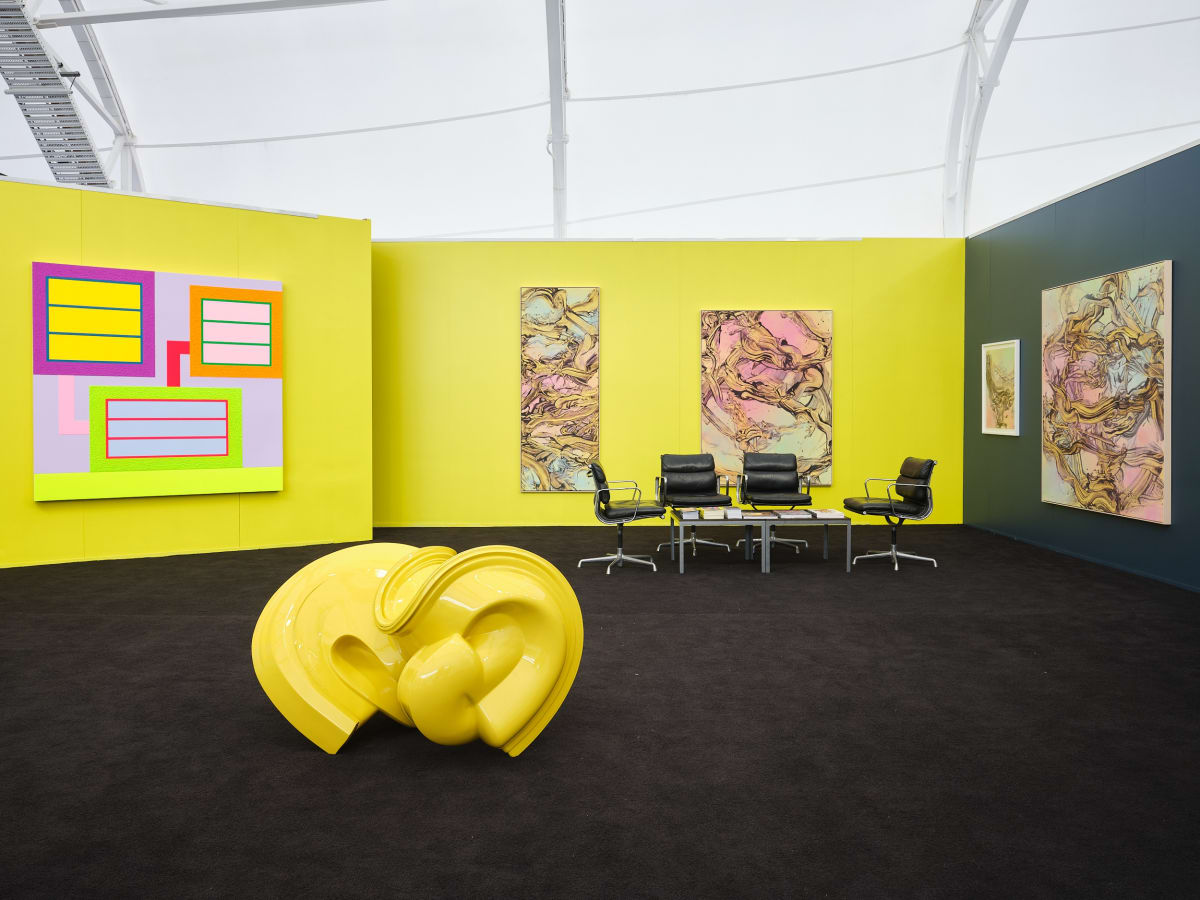Jacqueline Fahey
Her distinctive painting style is recognisable for a raucous use of colour, with often haphazard use of perspectival space to force the viewer into the claustrophobia of the female experience. You can hear Fahey’s paintings. Expertly realised portraits are candid in their expressions – characters are shown mouth open, mid argument, or gazing off absentmindedly into the distance.
b. 1929, Timaru
Lives and works in Auckland, NZ
Now in her nineties, Jacqueline Fahey is one of few female career artists of her generation and she continues to push the boundaries of societal structures and politics within her work. Combining vivid portrayals of urban and suburban landscapes with figurative components, she makes observations of people and how we live and communicate. With the rich use of colour and intimate detail in her compositions, her work challenges the status quo and encourages new ways of looking.
Married and a mother to three early in her painting career, the stifling gendered society of 1950s and 1960s New Zealand saw Fahey adopt unconventional colour, technique, and subject matter to reflect and actively challenge the status quo of the gender divide. Yet embedded in the artist’s pugnacious approach is a great level of affection for the women and relationships portrayed, evident in the careful detail bestowed on traditionally ‘female’ interests – clothing, interior textiles, bouquets- elevating the decorative female space above the austere settings more familiar to portraiture.
Her distinctive painting style is recognisable for a ravishing use of colour, and her perception of the beauty of the objects that make up a domestic scenario is acute. Her deliberate use of perspectival space forces the viewer into the claustrophobia of the female experience. You can hear Fahey’s paintings. Expertly realised portraits are candid in their expressions – characters are shown mouths open, mid-argument, or gazing off absentmindedly into the distance. Glimpses of TV sets, record players, and radios are combined with closely observed wine glasses, cups of tea, and bottles of gin. The clamour of crockery and conversation rings through the paintings and spills out into our space as they do into the painted gardens visible through open windows. Later bodies of work see Fahey applying her distinctive flare to urban environments and urban characters, translating domestic politics to their manifestation in the public environment.
Born in Timaru in 1929, Fahey began her painting education in earnest at sixteen, at the Canterbury College School of Art, now Ilam. During this time, she became friends with notable members of the Christchurch collective of exhibiting artists, The Group, Rita Angus and Doris Lusk. Of these friendships and their impact on her practice, she says, "It wasn't so much that they influenced the way I painted. What they did was allow me to be professional, to think of it as my life." Not content only painting her feminism, Fahey has been instrumental in promoting female peers, organising the first actively ‘gender-balanced’ exhibition with Rita Angus, which was staged at Centre Gallery, Wellington in 1964. Her contribution to feminist art is recognised here and internationally, and two of her paintings were featured in the major exhibition WACK! Art and the Feminist Revolution (2007) at the Museum of Contemporary Art, Los Angeles, which toured to MoMA PS1 the following year.
In addition to painting, Fahey is a novelist, having published a novel and two volumes of memoirs. In 1997 she was named an Officer of New Zealand Merit (ONZM) for her services to art, and in 2013 she was granted an Arts Foundation Icon Award, the organisation’s highest honour and restricted to a circle of twenty living artists.
Gow Langsford Gallery has represented Jacqueline Fahey since 2020.
-
 Look Mum - They Killed Her!, 2022
Look Mum - They Killed Her!, 2022 -
 I Tell You I Saw it Myself!, 2016
I Tell You I Saw it Myself!, 2016 -
 That is life, 2009
That is life, 2009 -
 Encounter with the Past, 2008
Encounter with the Past, 2008 -
 Tragedy outside the dairy II, 2003
Tragedy outside the dairy II, 2003 -
 K Rd, 1998
K Rd, 1998 -
 Why are you doing this?, 1998
Why are you doing this?, 1998 -
 Untitled, 1993
Untitled, 1993 -
 Grandma and Emily, 1992
Grandma and Emily, 1992 -
 Christmas Day, 1986
Christmas Day, 1986 -
 Augusta and Lucy taking up the theatre, 1981-82
Augusta and Lucy taking up the theatre, 1981-82 -
 Portrait of the Poet, 1978
Portrait of the Poet, 1978 -
 Mum, Christmas Day, 1971
Mum, Christmas Day, 1971
-

Manifesto!
Jacqueline Fahey 17 May - 10 Jun 2023 Auckland CityGow Langsford Gallery is proud to present Manifesto!, Jacqueline Fahey’s second solo exhibition with the gallery.This exhibition shows works from a broad cross section of the distinguished painter’s career output, with works dating from the early 1970s up until the present. Manifesto! highlights Fahey's artistic vision, technical finesse, and the diverse range of content that she has engaged with over the decades.Read more -

Defences Against The Void
Jacqueline Fahey 21 Apr - 15 May 2021 Auckland CityGow Langsford Gallery is delighted to present the gallery’s first exhibition with Art Foundation Icon Jacqueline Fahey ONZM. Fahey’s paintings collide portraiture with urban and suburban landscapes to create riotously colourful compositions which revel in the chaos of the everyday. Defences Against the Void demonstrates that throughout her lengthy career, Fahey’s subject matter has varied considerably, but her pugnacious approach has not. They are intimate observations of social practices, constructs, and politics, grounded in close consideration of how these issues affect the daily lives of those around her.Read more

















